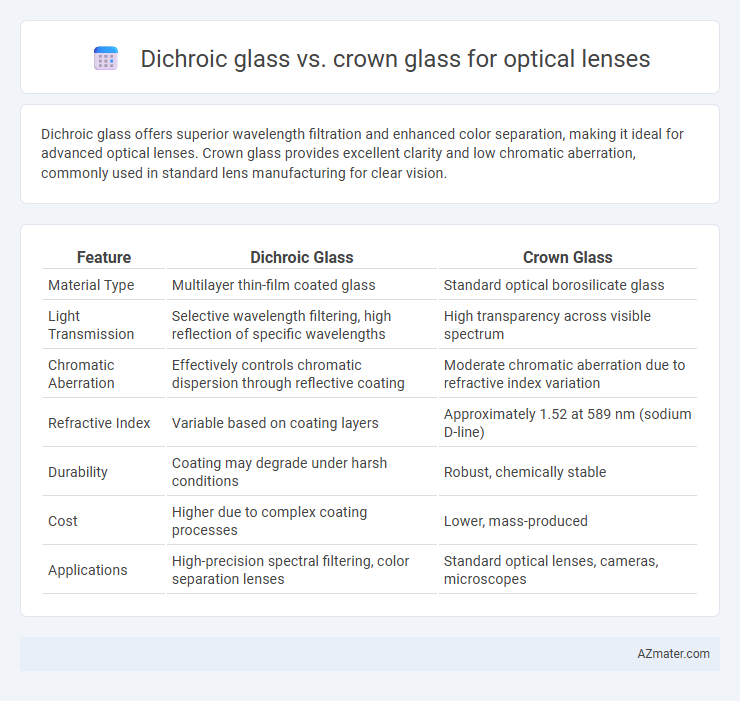Dichroic glass offers superior wavelength filtration and enhanced color separation, making it ideal for advanced optical lenses. Crown glass provides excellent clarity and low chromatic aberration, commonly used in standard lens manufacturing for clear vision.
Table of Comparison
| Feature | Dichroic Glass | Crown Glass |
|---|---|---|
| Material Type | Multilayer thin-film coated glass | Standard optical borosilicate glass |
| Light Transmission | Selective wavelength filtering, high reflection of specific wavelengths | High transparency across visible spectrum |
| Chromatic Aberration | Effectively controls chromatic dispersion through reflective coating | Moderate chromatic aberration due to refractive index variation |
| Refractive Index | Variable based on coating layers | Approximately 1.52 at 589 nm (sodium D-line) |
| Durability | Coating may degrade under harsh conditions | Robust, chemically stable |
| Cost | Higher due to complex coating processes | Lower, mass-produced |
| Applications | High-precision spectral filtering, color separation lenses | Standard optical lenses, cameras, microscopes |
Introduction to Optical Lens Materials
Dichroic glass and crown glass serve distinct roles in optical lens manufacturing due to their unique refractive indices and dispersion properties. Dichroic glass offers precise wavelength filtering capabilities, making it ideal for applications requiring selective light transmission, while crown glass is favored for its low dispersion and high clarity, resulting in reduced chromatic aberration in standard lens systems. Understanding these material characteristics is essential for optimizing lens performance in imaging and photonic devices.
Overview of Dichroic Glass
Dichroic glass is an advanced optical material characterized by its multilayer thin-film coatings that selectively reflect specific wavelengths while transmitting others, enhancing color separation and light management in lenses. This unique property enables superior control over spectral transmission and reflection compared to traditional crown glass, resulting in improved image clarity and contrast in optical applications. Its precise wavelength filtering makes dichroic glass highly suitable for high-performance lenses in scientific instruments, cameras, and laser systems.
Key Properties of Crown Glass
Crown glass, primarily composed of silica and potassium oxide, offers high optical clarity and relatively low dispersion with an Abbe number around 60, making it ideal for reducing chromatic aberration in lenses. Its refractive index typically ranges from 1.52 to 1.54, providing balanced light bending suitable for standard optical applications. Compared to dichroic glass, crown glass is more cost-effective and easier to manufacture, but lacks the specialized wavelength-selective filtering properties inherent to dichroic coatings.
Light Transmission and Filtering Differences
Dichroic glass offers superior light transmission control by selectively filtering specific wavelengths through multiple thin-film coatings, resulting in enhanced color separation and minimal light loss. In contrast, crown glass provides more uniform light transmission with limited filtering capabilities, primarily relying on its refractive index for lens performance. The advanced wavelength filtering properties of dichroic glass make it ideal for applications requiring precise light management, while crown glass is preferred for general-purpose optical lenses due to its balanced clarity and cost-effectiveness.
Optical Performance Comparison
Dichroic glass offers superior wavelength-selective filtering and enhanced color separation, significantly improving contrast and image clarity in optical lenses compared to crown glass. Crown glass provides excellent light transmission and low dispersion, making it ideal for basic lens applications with minimal chromatic aberration. The choice between dichroic and crown glass depends on the required optical performance, with dichroic glass excelling in applications demanding precise spectral control and crown glass favored for cost-effective, high-transparency optics.
Durability and Longevity of Both Materials
Dichroic glass exhibits superior durability and longevity compared to crown glass due to its multi-layer coating, which enhances resistance to scratches, impacts, and environmental factors. Crown glass, while commonly used in optical lenses for its clarity and refractive properties, is more prone to chipping and wear over time under mechanical stress. The enhanced hardiness of dichroic glass makes it especially suitable for applications requiring long-term optical performance and durability in demanding conditions.
Cost Considerations: Dichroic vs Crown Glass
Dichroic glass lenses typically incur higher manufacturing costs due to their complex multi-layer coatings that enhance color separation and light filtering capabilities, making them more expensive than standard crown glass lenses. Crown glass, widely used for optical lenses, offers a cost-effective solution with good optical clarity and durability, suitable for everyday applications without the additional expense of specialized coatings. The choice between dichroic and crown glass lenses balances performance requirements against budget constraints, with dichroic glass favored in high-precision or color-sensitive optics despite its higher price point.
Common Applications in Optics
Dichroic glass is primarily used in advanced optical applications such as beam splitters, filters, and laser systems due to its ability to selectively reflect and transmit specific wavelengths of light. Crown glass, known for its low dispersion and high clarity, is commonly utilized in eyeglasses, cameras, and microscopes where image quality and minimal chromatic aberration are essential. Optical lenses often combine these materials to optimize performance in precision instruments and imaging devices.
Advantages and Disadvantages Summarized
Dichroic glass offers superior light filtering and color separation due to its multi-layer coatings, enhancing contrast and reducing chromatic aberrations in optical lenses. Crown glass provides higher optical clarity with lower dispersion, making it ideal for general-purpose lenses but less effective at selective wavelength filtering. While dichroic glass excels in applications requiring precise wavelength control, its cost and complexity are higher compared to the simpler, more affordable crown glass lenses.
Choosing the Best Glass for Your Optical Needs
Dichroic glass offers superior light filtering and color separation through multiple thin-film layers, enhancing visual clarity in specialized optical applications, while Crown glass is prized for its low dispersion and high refractive index, making it ideal for general-purpose lenses with minimal chromatic aberration. When choosing the best glass for your optical needs, consider factors such as required wavelength filtering, optical clarity, mechanical durability, and cost-effectiveness. For high-precision applications like microscopy or laser systems, dichroic glass excels, whereas crown glass suits everyday corrective lenses and imaging devices due to its established optical properties and affordability.

Infographic: Dichroic glass vs Crown glass for Optical lens
 azmater.com
azmater.com